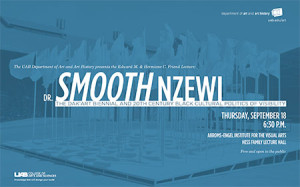University of Alabama at Birmingham – Lecture
Ugochukwu-Smooth C. Nzewi
“The Dak’Art Biennial and 20th Century Black Cultural Politics of Visibility.”
Thursday, Sept. 18, 6:30 p.m.
UAB Department of Art and Art History
College of Arts and Sciences’ Abroms-Engel Institute for the Visual Arts
Hess Family Lecture Hall, 1221 10th Ave. South
The entrance is free and open to the public. Call 205-975-6267
Dr. Ugochukwu-Smooth C. Nzewi is an artist, art historian, and curator of African art at the Hood Museum of Art, Dartmouth College, Hanover, New Hampshire. He holds a B.A. in Fine and Applied Arts from the University of Nigeria Nsukka, Nigeria, a postgraduate diploma in Museum and Heritage Studies from the University of Western Cape, South Africa, and a Ph.D. in Art History from Emory University. Nzewi has participated in international artists’ residency and workshop programs, and over 35 art exhibitions in Africa, Europe, and the United States. He has curated exhibitions in Africa and the United States, such as Afrika Heritage Biennial in Nigeria (2002, 2004, and 2007), Transitions: Contemporary South African Works on Paper at the High Museum Atlanta, USA in 2009, and the Dak’Art Biennial in 2014. He is a recipient of several academic fellowships, scholarship, and artists’ awards, including Robert Sterling Clark Foundation Fellowship (2011) and Smithsonian Institution Pre-Doctoral Fellowship (2012).
His recent essays include “The Individual and Community: Aesthetics of Blackness in the works of three Black British Artists,” Critical Interventions, No. 12 (Fall 2013), “The Contemporary Present and Modernist Past in Postcolonial African Art,” World Art, Issue 3, No. 2 (autumn/fall 2013),” and “Curating Africa, Curating the Contemporary: The Pan-African Model of Dak’Art Biennial,” SAVVY: Journal of contemporary African Art, [special edition on Curating: Expectations and Challenges] No. 4 (November 2012). He is a contributor to Grove Art Online summer 2014 update on African Art and Architecture, Oxford University Press, and co-editor of New Spaces for Negotiating Art (and) Histories (forthcoming), a book on independent art initiatives in Africa.
The announcement of the creation of Dak’Art 1989 marked a pivotal moment in African and international art scenes. President Abdou Diouf’s government had emerged from the worst part of Senegal’s economic crisis in the 1980s, and was ready to revert to international cultural diplomacy as crucial to national development and economic growth. The mainstream artworld had also begun to re-examine the meaning of internationalism with groundbreaking exhibitions such as Magicians of the Earth and Another Story. Yet, these events at the twilight of the decade preceding the expansion of the art world and the emergence of new forms of cultural mediation in the 1990s do not fully explain what precipitated Dak’Art. A full picture must include a rigorous engagement with 20th century global black cultural politics, which inspired and continue to drive Dak’Art’s geopolitical focus. This lecture maps this history.
Throughout the twentieth century, the essence of black cultural politics was the aspiration for institutionalized political and cultural visibility. The tenor of the quest has continued to evolve with changing historical and contemporary conditions. The Dak’Art Biennial in Senegal responds to the specifics of contemporary cultural politics, but with the benefit of a complex and often difficult black history. Several pan-African conferences and cultural fora organized between 1900 and1959 in different locations in the Western world explored racial uplift, and attempted to forge a united political front against racism and colonialism.
These events promoted interaction among black people from different countries and provided an initial context for pan-African internationalism to blossom. This particular pan-Africanist spirit culminated in the black cultural congresses in Europe at the twilight of colonialism, and later manifested in the pan-African cultural festivals in Africa. The early pan-African congresses and festivals, including the International Congress of African Culture in Salisbury (Harare) in 1962, and the First World Festival of Negro Arts in Dakar in 1966, the First Pan-African Festival in Algiers in 1969, and the Second World Festival of Black and African Arts in Lagos in 1977, made a case for black cultural visibility on a global scale. Significantly, they gave international recognition to modern black and African artists, a role currently championed by Dak’Art for contemporary artists of African descent.
The lecture will be published afterwards on the Website of UAB Department of Art and Art History.


